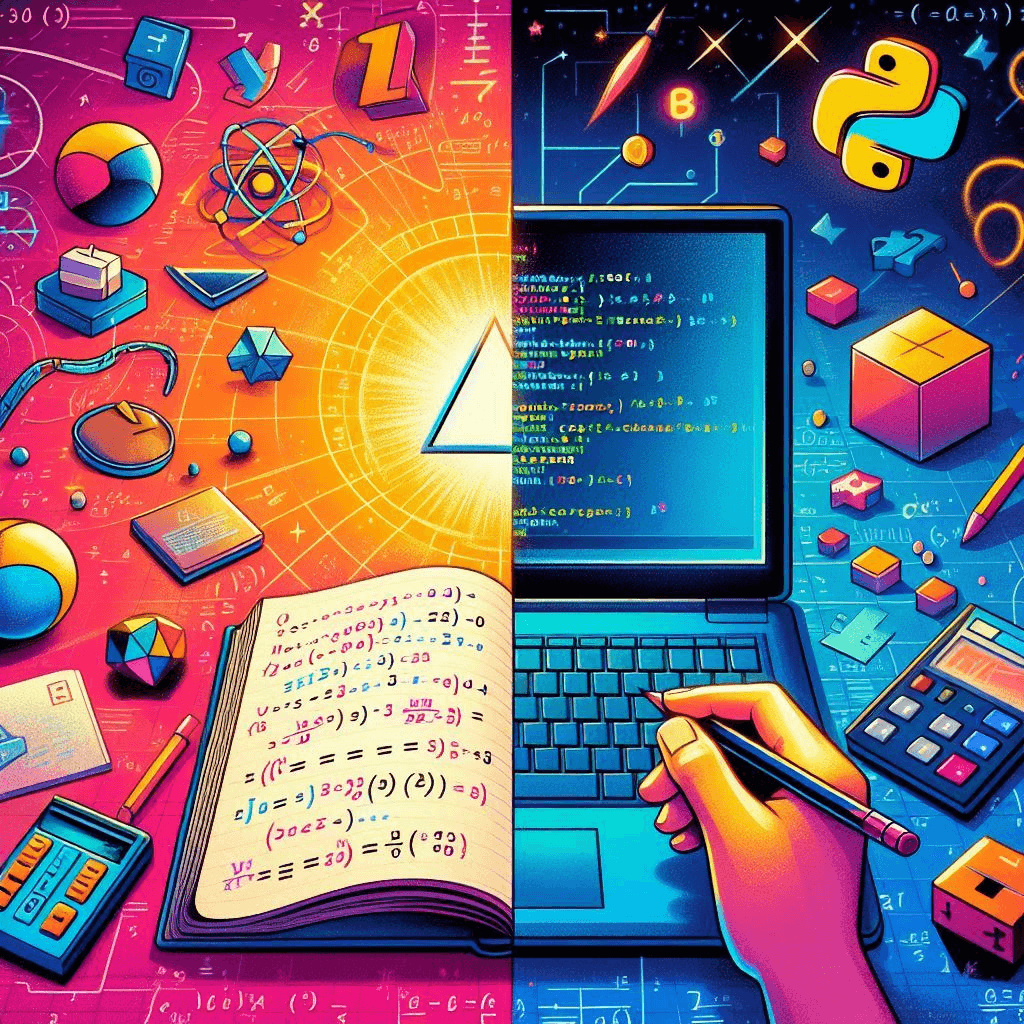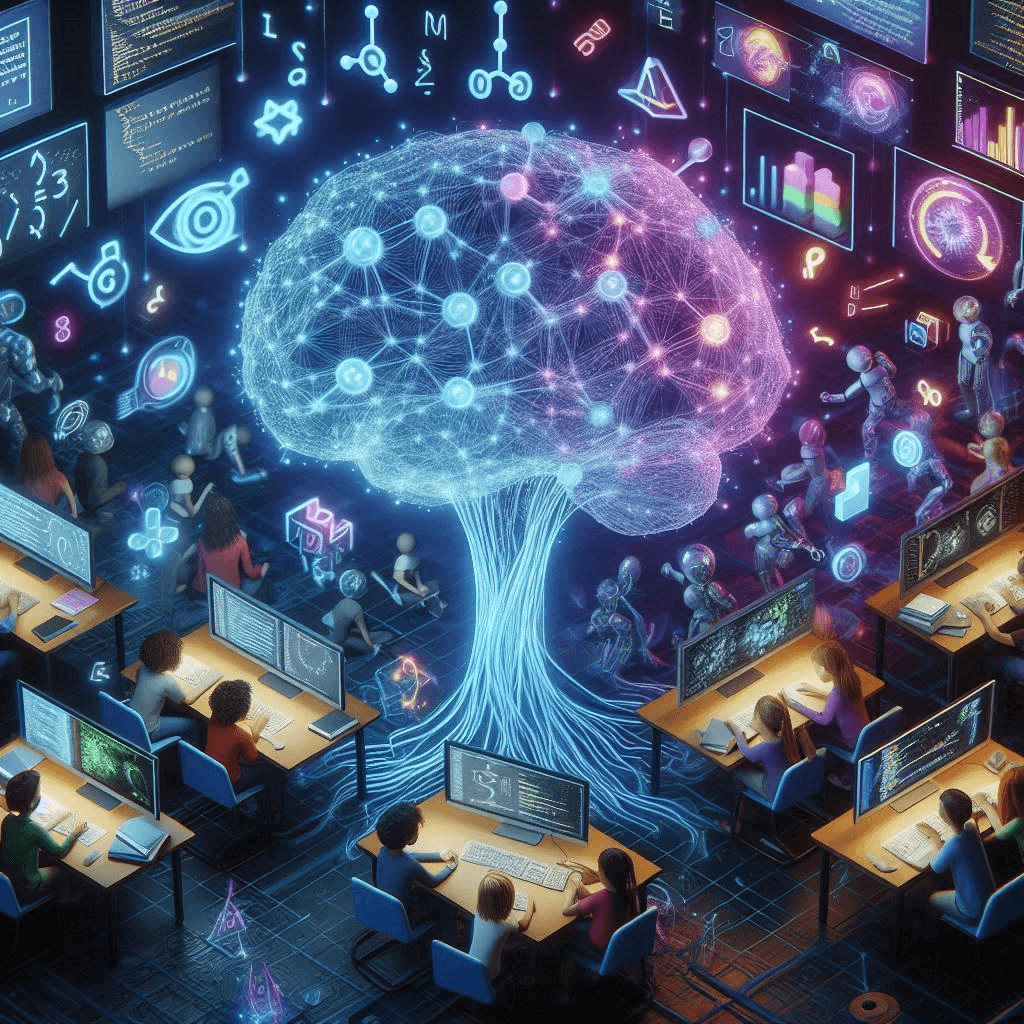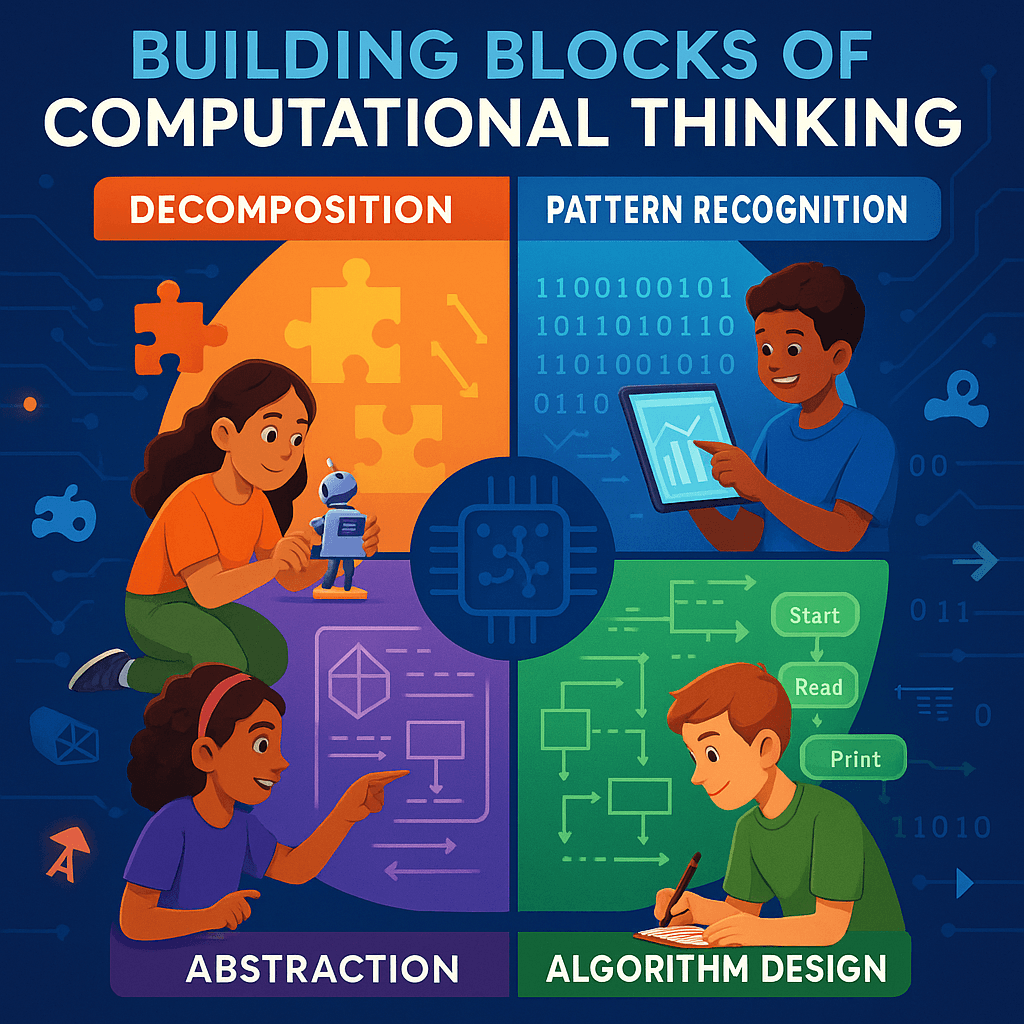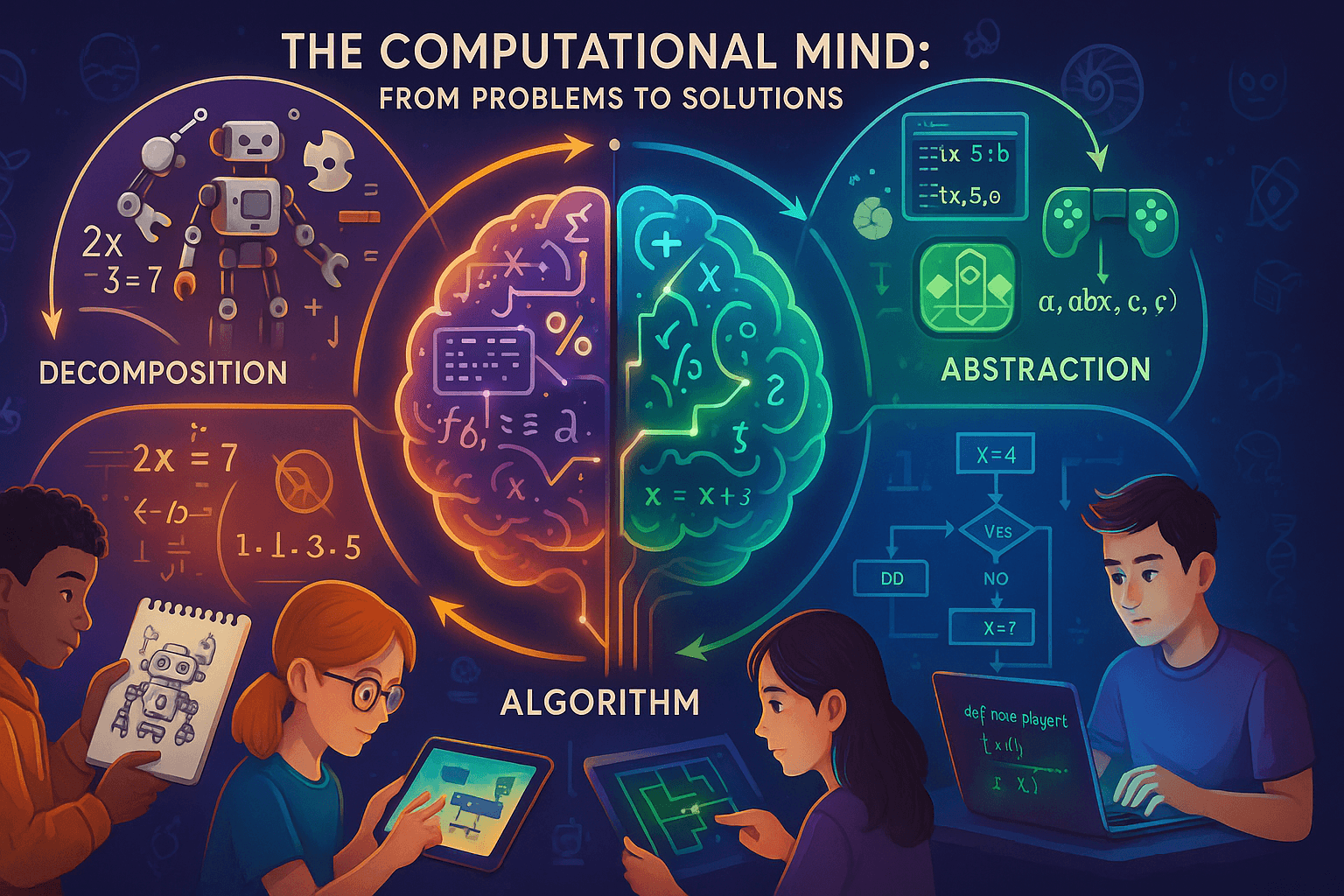How Math and Coding Work Together to Build Logical Thinking
How Math and Coding Work Together to Build Logical Thinking
Math and coding might seem like separate subjects,but they complement each other. Both teach structured thinking, problem-solving and analytical reasoning. Coding helps kids improve their math skills and by practicing math makes coding easier to grasp. This connection supports how coding improves math skills naturally.
Technology-driven world need kids to blend these two fields. This helps them gain important skills for future jobs in science, engineering, AI and game development. This article shows how coding boosts math skills, sharpens logical thinking and get students ready for STEM careers.

How Coding Improves Math Skills
Coding helps children visualise math operations in real-world scenarios. It builds fluency in key areas like logic, sequencing, pattern recognition, and conditionals. When kids write code, they are applying math concepts in programming like functions, variables, and algorithms.
Coding turns abstract math concepts into interactive, hands-on experiences. When kids write programs, they apply mathematical principles in real-world scenarios. Here’s how coding boosts math skills:
1. Loops Teach Multiplication and Repeated Addition
In programming, loops repeat actions, just like multiplication is repeated addition.
A for loop that runs 5 times to add 3 each time is the same as calculating 3 × 5.
For LoopStart: 0After 1st add: 0 + 3 = 3After 2nd add: 3 + 3 = 6After 3rd add: 6 + 3 = 9After 4th add: 9 + 3 = 12After 5th add: 12 + 3 = 15Multiplication:3 × 5 = 3 + 3 + 3 + 3 + 3= (3 + 3) + (3 + 3) + 3= 6 + 6 + 3= 12 + 3= 15Kids see how math operations work behind the scenes, making arithmetic more natural.
2. Variables Work Like Algebra
Variables in coding store and manipulate data, similar to algebraic equations.
If x = 5 and y = x + 3, then y = 8.
This helps kids grasp how symbols represent numbers in math.
3. Conditional Statements Support Logical Reasoning
Programming uses if-else statements, which rely on Boolean logic (True/False).
Example:
if score > 50: print("You passed")else: print("Try again")The above replicates solving inequalities in math (Example: Is 7 > 5?)
4. Debugging Sharpens Problem-Solving Skills
Finding and fixing errors in code is like checking steps in a math problem.
Kids learn to:
Identify mistakes
Test different solutions
Stick to the problem until they find the right answer
5. Game Development Applies Math in Fun Ways
By coding games, kids see how math powers real-world applications. Creating simple games involves:
Scoring systems (addition/subtraction)
Movement mechanics (x-y coordinates, geometry)
Timers and speed (calculations with variables)
Building Logical Thinking Through Programming
Programming teaches children to think with precision and structure. When kids write code, they develop essential problem-solving skills that apply to mathematics, science, and everyday life. This step-by-step process of breaking down complex problems into manageable parts forms the foundation of computational thinking and problem solving.
Why Coding Develops Superior Logical Reasoning
1. Strengthens Critical Thinking Skills
Forces students to analyze problems before solving them
Requires understanding cause-and-effect relationships
Example: Debugging code shows how small changes can impact whole programs
2. Enhances Decision-Making Abilities
Presents multiple ways to solve problems
Teaches evaluation of different approaches
Example: Choosing between loops or recursive functions
3. Builds Focus and Persistence
Programming requires attention to detail
Debugging teaches patience and resilience
Example: Finding one missing semicolon among 100 lines of code
Math-Based Coding Exercises for Kids
These hands-on projects help children learn mathematical concepts through practical programming tasks:
1. Build a Calculator (Python/Scratch)
Reinforces arithmetic operations
Teaches input/output handling
Example code:
def add(x, y): return x + y2. Create a Coin Counter
Practices decimal addition
Applies to real-world applications like budgeting
Skills gained:
Variable usage
Basic arithmetic
User input processing
3. Design a Multiplication Quiz
Makes math practice interactive
Uses loops and conditionals(if statements)
Benefits:
Reinforces time tables
Introduces scoring systems
4. Program a Simple Graph Plotter
Visualizes algebraic equations
Teaches coordinate geometry
Example: Plotting y = 2x + 3
STEM Learning with Coding and Math
STEM education combines science, technology, engineering, and math to develop critical thinking skills and problem-solving abilities. When kids learn coding alongside math, they gain practical tools to solve complex problems in real-world applications. This powerful combination prepares them for careers in artificial intelligence, game development, machine learning, and other STEM fields.
Why Coding and Math Work Together in STEM
Coding makes abstract mathematical concepts concrete. Kids see how mathematical principles apply to programming tasks:
Variables in algebra become storage containers in code
Geometric coordinates control movement in games
Boolean logic (true/false) powers if statements
Algorithms provide step-by-step solutions to math problems
This connection helps children learn difficult concepts through hands-on experience.
Key Benefits of Integrated STEM Learning
1. Sparks Innovation and Creativity
Coding projects encourage students to explore new ideas
Math challenges inspire creative problem-solving approaches
Example: Designing a game requires both logical reasoning and imagination

2. Shows Real-World Math Applications
Students understand why math matters through:
Building simple apps (computer science)
Creating animations (computer graphics)
Analyzing data (data analysis)
3. Prepares for High-Demand Careers
Robotics: Uses geometry and physics
Artificial Intelligence: Relies on statistics and algorithms
Game Development: Requires linear algebra and physics
Scientific Research: Involves conducting experiments and analyzing data
Understanding Math Concepts in Programming
Math and programming use similar thought processes. Many programming concepts, such as variables, functions, coordinates and conditionals, come from math logic.
Math Concept | Programming Application |
|---|---|
Algebra | Variables store changing values |
Geometry | X/Y coordinates position game characters |
Arithmetic | Basic calculations in program logic |
Boolean Logic | Controls program flow with true/false conditions |
Data Structures | Organizes information efficiently+ |
Understanding these math elements makes programming more natural and accessible for young learners.
Developing Computational Thinking Skills
STEM learning teaches the computational thinking process:
Break Down Problems
Coding helps boost math skills by showing students how to break down complex tasks into smaller, logical steps.
In game development, a project includes many parts: physics for solving equations, graphics using linear algebra, and AI for logical reasoning. By separating these tasks, students learn how to solve complex problems systematically.
Programmers need to break large computations, such as data analysis or machine learning, into smaller parts. This helps them use key math concepts like floating-point numbers and Big O notation.
This method is like how mathematicians tackle proofs. They break them into smaller theorems and check each step.
Example: A student coding a simple calculator must handle addition, subtraction, multiplication, and division one at a time. It’s like solving equations step by step.
Recognize Patterns
Pattern recognition is a fundamental aspect of both math and programming. Identifying repeated structures helps in developing algorithms and simplifying calculations.
Loops, like for and while, help replace manual calculations. They teach students to optimize solutions. For example, you can sum numbers without writing every step.
Data structures like arrays and matrices use set theory and linear algebra. They help students see abstract math concepts clearly.
In machine learning, spotting trends in data boosts statistical analysis. This also helps with predictive modeling, and these skills apply directly to math.
Example: A programmer can write 5 * 4 instead of 5 + 5 + 5 + 5. This shows that multiplication is just repeated addition.

Abstract Key Ideas
Programming helps students focus on core logic and ignore unnecessary details. This skill is key for understanding abstract math concepts. It combines complex operations, such as solving quadratic equations, into a reusable function.
A variable, like an algebraic expression such as (x + 5 = 10 ), can represent unknown values.
OOP- devices are real-world systems in action. They include things like chemical reactions and physical modeling. Their foundation is built on important mathematical principles.
Example: When you have a function to compute the area of a circle (πr²), it captures that formula. Then, students can use it anywhere without needing to re-derive it.
Design Step-by-Step Solutions
Coding makes you think in a structured way. So, the solution follows a logical order, just like a math proof.
Pseudo code outlines the algorithm in a clear way before coding. It’s similar to writing down steps when solving a problem.
If-else statements teach logical reasoning. This skill is vital for solving inequalities and working with Boolean algebra.
Debugging needs precision. It's like solving equations. A small mistake leads to a wrong answer.
Example: Creates a sorting algorithm like Bubble Sort. This requires knowing how to compare and swap items, similar to math principles of order.
Computational Thinking and Problem-Solving Through Coding
Computational thinking and problem solving are revolutionizing how we approach complex problems in computer science, mathematics and everyday life. This problem-solving process gives students a structured framework to tackle challenges methodically which is a fundamental aspect of both programming and mathematical reasoning. Let's see how developing these thinking skills through coding can transform a child's ability to solve complex problems.
1. Decomposition:
Decomposition teaches students to divide complex tasks into smaller, manageable parts. This is a crucial skill in both writing code and solving equations.
When building a game (a real-world application of computer graphics), students learn to separate:
Character movement (using coordinate geometry)
Scoring system (applying arithmetic operations)
Level design (applying pattern recognition)
Mathematical Connection: Solving multi-step algebra problems uses the same approach:
Isolate variables
Simplify equations
Solve sequentially
This step-by-step process replicates how programmers structure functions in any programming language.
2. Pattern Recognition:
Identifying patterns is essential for developing algorithms and solving mathematical concepts efficiently. In coding, you will notice repeating code blocks that can become loops. In mathematics, you will see similar structures across different problems. This critical thinking skill is especially valuable in computer graphics and game development where visual patterns appear constantly
Coding Applications:
Using loops instead of repetitive code
Recognizing similar functions that can be abstracted
# Instead of:print("Hello Codeyoung")print("Hello Codeyoung")print("Hello Codeyoung")# Use pattern recognition:for i in range(3): print("Hello Codeyoung")Math Connections:
Identifying number sequences (Fibonacci, arithmetic progressions)
Seeing symmetry in geometric proofs
Applying formulas to similar problem types

3. Algorithm Design: Creating Step-by-Step Solutions
Algorithms are the heart of both computer science and mathematical principles. Algorithms are like perfect recipes for problem solving. Before writing code, smart programmers plan with pseudo code. This mirrors showing your work in math problems. Learning this process helps with everything from building apps to conducting experiments.
In Programming:
Writing clear instructions for tasks like:
Sorting data (using data structures)
Path finding in games
Processing user inputs
In Mathematics:
Standard procedures for:
Solving equations
Performing matrix operations (linear algebra)
Calculating probabilities

4. Abstraction:
Abstract concepts become clearer when you learn to ignore distracting details. In programming, you create functions that hide complexity. In math, you use variables to represent numbers. This powerful tool helps whether you're working with data structures or analyzing information in scientific research
Coding Examples:
Using functions to hide complexity
Creating classes to represent real-world applications
def calculate_area(radius): return 3.14 * radius * radiusMathematical Applications:
Working with variables instead of specific numbers
Understanding floating point number representations
Applying set theory concepts
This skill is crucial for advanced topics like Artificial Intelligence and Machine Learning.
Practical Applications Table
Skill | Coding Example | Math Connection | STEM Application |
|---|---|---|---|
Decomposition | Separating game components | Breaking word problems into steps | Machine learning data preparation |
Pattern Recognition | Using loops instead of repeating code | Identifying equation patterns | Artificial intelligence training |
Abstraction | Creating functions | Working with variables | Data analysis techniques |
Algorithm Design | Writing program logic | Showing math solutions | Scientific research methods |
Conclusion
Math and coding influence how children think and solve problems. This bond helps them face challenges in school and in their daily lives. Mixing math with programming help kids think critically. They learn to break down tough problems into smaller and easier steps.
They prepare students for STEM fields, such as Artificial Intelligence and Data Analysis. Hands-on activities help make abstract ideas clear. For example, building calculators or creating games can strengthen logical thinking. When we teach coding alongside math, we provide children with powerful tools to navigate an increasingly digital world through STEM learning with coding and math.
Math and Coding – FAQs
How does coding improve math skills, and what concepts does it reinforce?
Coding enhances math skills by focusing on key areas like operations, functions and logic. It teaches students computational thinking and problem solving. This means they learn to break complex problems into smaller parts. They also design algorithms to solve these problems.
Working on programming tasks helps students understand "mathematical phenomena" like set theory and linear algebra. These concepts are crucial for fields such as Data Analysis and Machine Learning.
Why is logical thinking through programming essential for problem-solving?
Logical thinking through programming builds the logic needed to solve problems through step-by-step identification. Students can predict results and use if statements. These skills help with solving equations and analyzing data. Structured thinking helps with computational thinking. It usually involves a complex system for handling issues in computer science and everyday life.
What are some engaging math-based coding exercises for kids to try at home?
Children can enhance their math skills through coding by:
Building a calculator app to practice operations and understand floating point numbers
Creating math quizzes that involves counting things and recognizing patterns
Using platforms like Scratch to animate word problems
Experimenting with game development to apply mathematical concepts
How does STEM learning with coding and math enhance future career opportunities?
STEM education prepares students for careers in Science, Technology, Engineering and Mathematics. It helps them to survive in today’s technology-driven world. Students learn coding and math and these skills help them with data analysis, logical reasoning and algorithm development. They are important for fields like Artificial Intelligence, Machine Learning and Game development.
Mathematical principles are heavily relied on in these disciplines and the principles of computing. Learning programming languages and data structures can lead to careers in computer science and research.
What are the most important math concepts in programming that kids should learn?
Several mathematical concepts are integral to programming and beneficial for children to grasp:
Arithmetic Operations: Understanding addition, subtraction, multiplication, and division is fundamental in coding.
Algebra: Working with variables and equations helps in developing dynamic programs.
Geometry: Knowledge of coordinates is important in computer graphics and game development.
Boolean Logic: Understanding True/False conditions helps you write better if statements.
Set Theory and Linear Algebra are key in machine learning and data analysis.
Learning these concepts helps children grasp the math behind programming. This boosts their problem-solving skills.
How does computational thinking and problem-solving help students in academics and beyond?
Computer and computational thinking involve clear steps for solving problems. These steps include:
Decomposition
Pattern recognition
Abstraction
Algorithm design
Students work through problems by breaking them down into simple parts. They use a systematic approach to find solutions. The method is useful in computer science, daily life, and many subjects. These skills help students think deeply about data analysis, experiments, and complex tasks. These skills also teach students the importance of critical and adaptable thinking. This thinking is useful in any career.